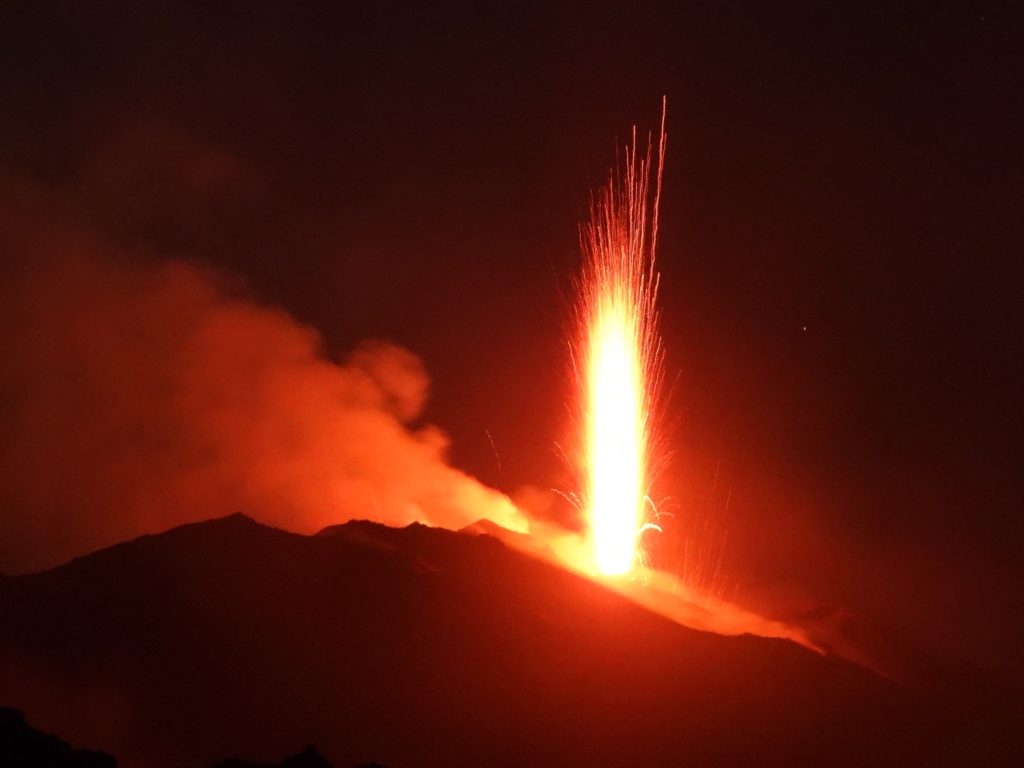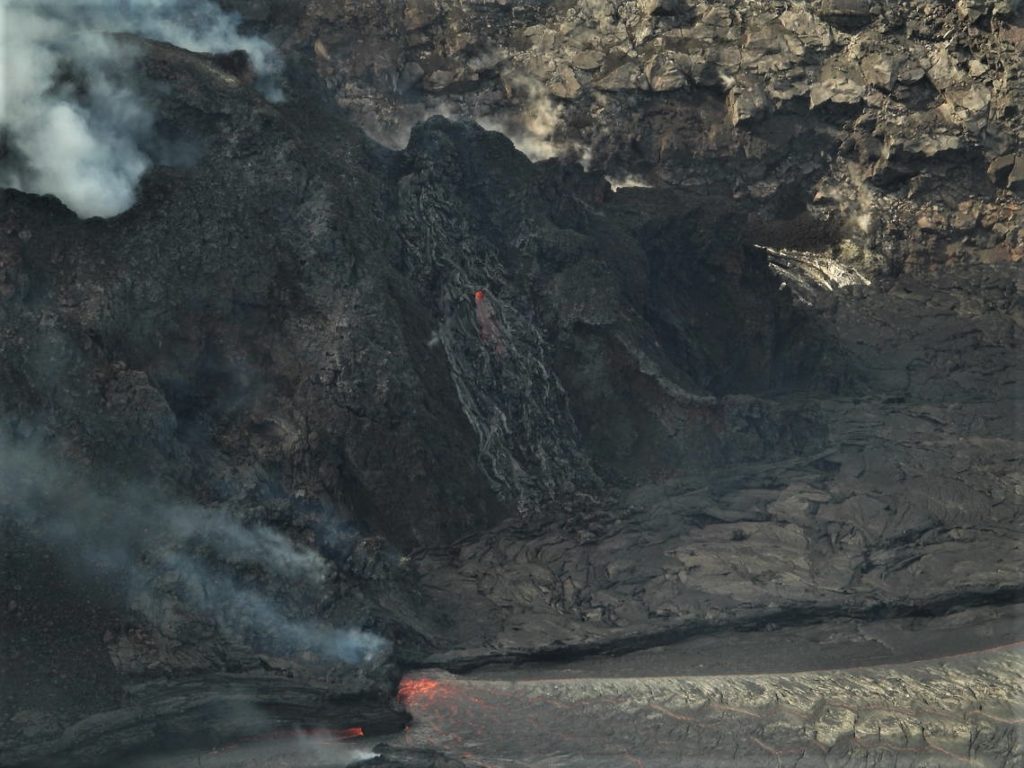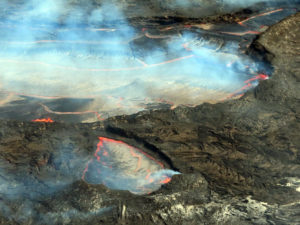February 24 , 2021 .
Italy , Stromboli :
Weekly bulletin, from February 15, 2021 to February 21, 2021 (issue date February 23, 2021)
SUMMARY OF THE STATE OF ACTIVITY
In the light of surveillance data, it is highlighted:
1) VOLCANOLOGICAL OBSERVATIONS: Normal explosive volcanic activity of Strombolian type with low projection activity in the North zone. The total frequency of events showed values between medium-low levels (9 events / h) and medium-low levels. high (17 events / h).
The intensity of the explosions was mainly medium-low in the North crater area and medium in the Center-South area.
2) SEISMOLOGY: The monitored seismological parameters do not show significant variations.
3) DEFORMATIONS: The island’s soil deformation monitoring networks did not show any significant changes during the period under review.
4) GEOCHEMISTRY: The flow of SO2 occurs at an average level
C / S ratio: the values are on average levels (C / S = 6.92 measurements of 02/21/2021).
The helium isotopic ratio is at high values (R / Ra = 4.42 compared to the sampling of February 5, 2021).
5) SATELLITE OBSERVATIONS: The thermal activity in the summit area is at a low level.
VOLCANOLOGICAL OBSERVATIONS
During the period under observation, the eruptive activity of Stromboli was characterized by the analysis of the images recorded by the surveillance cameras INGV-OE located at 190 m altitude, Punta Corvi and 400 m.
In the area of the North crater, the N1 crater, with two emission points, produced explosions of low intensity (less than 80 m high) to medium-high intensity (sometimes the projectiles reached 250 m high) emitting coarse materials (lapilli and bombs) mixed with fine materials (ash). The N2 vent, at four emission points, mainly showed low and medium-high intensity explosive activity (sometimes the products reached 250 m in height) emitting coarse materials. In addition, weak projection activity was observed at vent N2 until February 17. The average frequency of the explosions varied from 7 to 14 events / h.
In the Center-South zone, the explosions were mixed / coarse ash emissions with medium and sometimes high intensity (the products exceeded 250 m in height). The explosive activity showed average hourly frequency values between 2 and 5 events / h.
During the week, the amplitude of the tremor had medium-low values, slightly decreasing.
Source : INGV.
Photo : Boris Behncke, 12 août 2019.
Italy / Sicily , Etna :
Weekly bulletin, from February 15, 2021 to February 21, 2021 (issue date February 23, 2021)
SUMMARY OF THE STATE OF ACTIVITY.
In the light of surveillance data, it is highlighted:
1) VOLCANOLOGICAL OBSERVATIONS: Paroxysmal episodes at the Southeast Crater, separated by intervals of relative calm; intra-crater explosive activity and degassing of other summit craters
2) SEISMOLOGY: low seismic activity of fracturing; significant and sudden variations in the amplitude of the tremor are correlated with the phases of volcanic activity.
3) INFRASONO: high infrasound activity.
4) DEFORMATIONS: The stations of the inclinometric network showed limited variations (0.1 – 1 microradians) during the four paroxysmal phases which occurred last week. The GPS network has not experienced significant changes. Detailed analyzes underway indicate a slight deflationary trend in the summit area.
5) GEOCHEMISTRY: The flow of SO2 is at an average level
HCl flux occurs at a medium-high level.
The CO2 flux from the soil remains at the mean degassing values.
The partial pressure of dissolved CO2 does not show significant changes.
There are no updates for the C / S report.
The isotopic ratio of helium is at medium-high values (last update of 01/27/2021)
6) SATELLITE OBSERVATIONS: The thermal activity in the summit area is at a high level.
VOLCANOLOGICAL OBSERVATIONS
Etna’s activity during the week in question was observed through the network of visual and thermal surveillance cameras, and by INGV-OE personnel in the field on various occasions during and after the eruptive events. .
During the week of February 15-21, 2021, the character of Etna’s eruptive activity underwent a decisive change. Persistent activity at the Southeast Crater continued until February 15 (SEC) and the other summit craters. A series of paroxysmal eruptive episodes began on the 16th and are continuing at the time of publication of this Bulletin.
The first episode took place in the late afternoon of February 16, after a gradual increase in Strombolian activity at the eastern vents of the Southeast Crater. A lava overflow followed at 17:05 UTC which caused the partial collapse of the cone that had formed at the vents of the Southeast Crater which produced a pyroclastic flow about 1.5 km long on the western edge of the Valle del Bove. Immediately afterwards, the activity of the lava fountain began, with jets 500 to 600 m high, which produced an eruptive column laden with pyroclastic material which rose to a height of several kilometers before being blown south by the wind. In the southern sector of the volcano as far as Catania, there were lapilli falls, while fine ashes were transported to Syracuse. The lava flows flowed into the Valle del Bove and the Valle del Leone; often violent explosive interactions took place in contact with snow accumulations. The climax ended around 6:00 p.m. UTC.
The second paroxysmal episode occurred on the night of February 17-18, about 30 hours after the previous one. The activity began at 10:30 p.m. UTC on the 17th with lava overflow from the East vents of the Southeast Crater and was followed shortly after midnight with the onset of lava fountain activity.
This event repeated in many ways the evolution of its predecessor, with lava flows towards the Valle del Bove, towards the North-East and the South-East, but this time also with a flow towards the South-West by the « mouth of the saddle ». The eruptive column was dispersed by the wind towards the southeast, causing fallout of pyroclastic material along an axis that connects the municipalities of Zafferana Etnea and Acireale. The lava fountains, which in times of maximum intensity reached heights of 600 to 700 m, ceased around 12:40 a.m. on February 18.
After an interval of about 32 hours, on the morning of February 19, the third paroxysmal episode of the week occurred. Also this time the activity was preceded by a lava overflow from the East vents of the Southeast Crater (07:55 UTC), followed by a rapid increase in explosive activity and the onset of fountain activity. of lava between 08:45 and 08:50 UTC.
Initially, only the eastern mouths produced the fountains, then at 08:53 UTC the « saddle mouth » was also activated. Thus, there were 4 to 5 vents, along an east-west line, which produced « fan » lava fountains. The eruptive column, which reached an altitude of about 10 km above sea level, was again pushed by the wind towards the south-east by ash fallout in the towns on this side of the volcano. The lava flows, directed towards the Valle del Bove and the Southwest, interacted strongly with the snow locally. At 10:10 a.m., the explosive activity ceased completely.
At the end of the afternoon of February 20, the appearance of a weak Strombolian activity marked the beginning of the fourth paroxysmal episode of the week. At 9:30 p.m., a small lava flow overflowed through a deep niche east of the Southeast Crater, heading towards the Valle del Bove. During this time, the explosive activity at the East vents increased very gradually, switching to the pulsating fountains around 10:00 PM. From 00:00 a.m. on February 21, a gradual activation of the more westerly mouths began, while from the eastward mouths the fountains began to form jets 600 to 800 m high.
Map of the lava field from February 20 to 21, with information on area, volume of flows, maximum length, and minimum altitude reached.
At 00:28, the activity intensified significantly, with jets exceeding 1000 m in height and causing abundant fallout of incandescent pyroclastic material on the cone of the Southeast Crater. For about 10 minutes, the lava fountains rose more than 1000 m from one of the eastern mouths; at the same time, an overflow of lava began from the « mouth of the saddle » to the southwest. An eruptive column rose 10 km above sea level; Due to the absence of wind, very fine ash fallout occurred in a limited area on the southwest flank of the volcano.
From 01:00, the lava fountains diminished one after the other and at 01:20 the explosive activity completely ceased. The lava flows, shorter and less voluminous than those of the previous paroxysm, flowed into the Valle del Bove and towards the southwest. On the evening of February 21, periodic ash emissions began both from the east vents and from the « saddle » vents.
Throughout the week, explosive activity continued inside the other summit craters; in particular, the Northeast Crater continually showed intense degassing and strong nocturnal lights, often pulses indicating intracrater explosive activity.
COMMUNICATION ON THE ACTIVITY OF ETNA, 23 February 2021, 11:38 (10:38 UTC).
The National Institute of Geophysics and Volcanology, Osservatorio Etneo, announces that at around 9:00 GMT, the eruptive activity at the Southeast Crater has ended. The lava flows are no longer supplied, the fronts of the longest flow in the Valle del Bove are at an altitude between 1700 and 1800 m. The lava flow directed towards the southwest has traveled only a few hundred meters overlapping the previous ones.
Regarding the average amplitude of the tremor, after the phase of increase reported in the previous press release, with medium-high values, it underwent a reduction and around 04:40 UTC it reached the average level where it is still maintains. The source of the volcanic tremor was located between the craters of Bocca Nuova and Voragine, at an altitude of 2400-2600 m above sea level.
The infrasound activity also underwent a significant decrease in both the occurrence rate and the energy of events, which are located at the Southeast Crater.
Further updates will be communicated shortly
Source : INGV.
Photos : Gio Giusa , Fiorenzo Ippolito via Sherine France.
Kamchatka , Klyuchevskoy :
VOLCANO OBSERVATORY NOTICE FOR AVIATION (VONA)
Issued: February 24 , 2021
Volcano: Klyuchevskoy (CAVW #300260)
Current aviation colour code: ORANGE
Previous aviation colour code: yellow
Source: KVERT
Notice Number: 2021-30
Volcano Location: N 56 deg 3 min E 160 deg 38 min
Area: Kamchatka, Russia
Summit Elevation: 4750 m (15580 ft)
Volcanic Activity Summary:
The flank eruption (lateral break) on the northwestern slope of Klyuchevskoy volcano continues to work. A bright incandescence over two craters of the flank eruption continues to observing on satellite and video images. The lava flows move from the craters. A mud flow along Krutenkaya River was noted on 23 February for about 7 km from the Klyuchi Village. KVERT continues to monitor Klyuchevskoy volcano.
A moderate gas-steam activity of the volcano continues. The danger of ash explosions up to 5-6 km (16,400-19,700 ft) a.s.l. from flank craters remains. Ongoing activity could affect low-flying aircraft.
Volcanic cloud height: NO ASH CLOUD PRODUSED
Other volcanic cloud information: NO ASH CLOUD PRODUSED
Source : Kvert.
Photo : Yu Demyanchuk via Sherine France.
Hawaii , Kilauea :
19°25’16 » N 155°17’13 » W,
Summit Elevation 4091 ft (1247 m)
Current Volcano Alert Level: WATCH
Current Aviation Color Code: ORANGE
Activity Summary:
Kīlauea Volcano is erupting. Lava activity is confined to Halemaʻumaʻu with lava erupting from a vent on the northwest side of the crater. Field measurements as of February 22 indicate the lava in the western (active) portion of the lake in Halema‘uma‘u is 216 m (712 ft) deep. Webcams show intermittent crustal foundering. The eastern portion of the lava lake has a stagnant and solidified surface crust. SO2 emission rates remain elevated but continue decreasing; measurements on February 22 were 600 t/day.
This photo shows a view of the western fissure, feeding the lava lake in Halema‘uma‘u at the summit of Kīlauea. The inlet zone, where lava is entering the lake, is visible at the bottom of the photo. Near the center of the photo, an area of lava driblets can be seen running down the flank of the western fissure’s cone
Summit Observations:
The most recent sulfur dioxide emission rate measurements from February 22 are about 600 t/d and continue to gradually drop— this rate is lower than the emission rates from the pre-2018 lava lake (around 5,000 t/d). The summit tiltmeters show the inflationary trend of a new DI event started early this morning after midnight. Seismicity remains stable, with elevated tremor and one minor earthquake.
Halemaʻumaʻu lava lake Observations:
The active western half of the lava lake was approximately 216 m (712 ft) deep as measured by field crews in the afternoon of February 22, 2021. The decrease in lava lake depth since yesterday coincides with the deflationary part of a DI event.
Observations yesterday afternoon indicated lava effusion continues at the western fissure, but is weaker and slower. The lava rapidly develops a thin crust while flowing outwards towards the east with occasional crustal foundering between the vent and main island, but not beyond the island. A thin surface crust has started forming around 3 small pieces of the spatter cone that have been in the lake and are very close to the vent.
Source : HVO.
Photo : USGS/ M. Patrick











